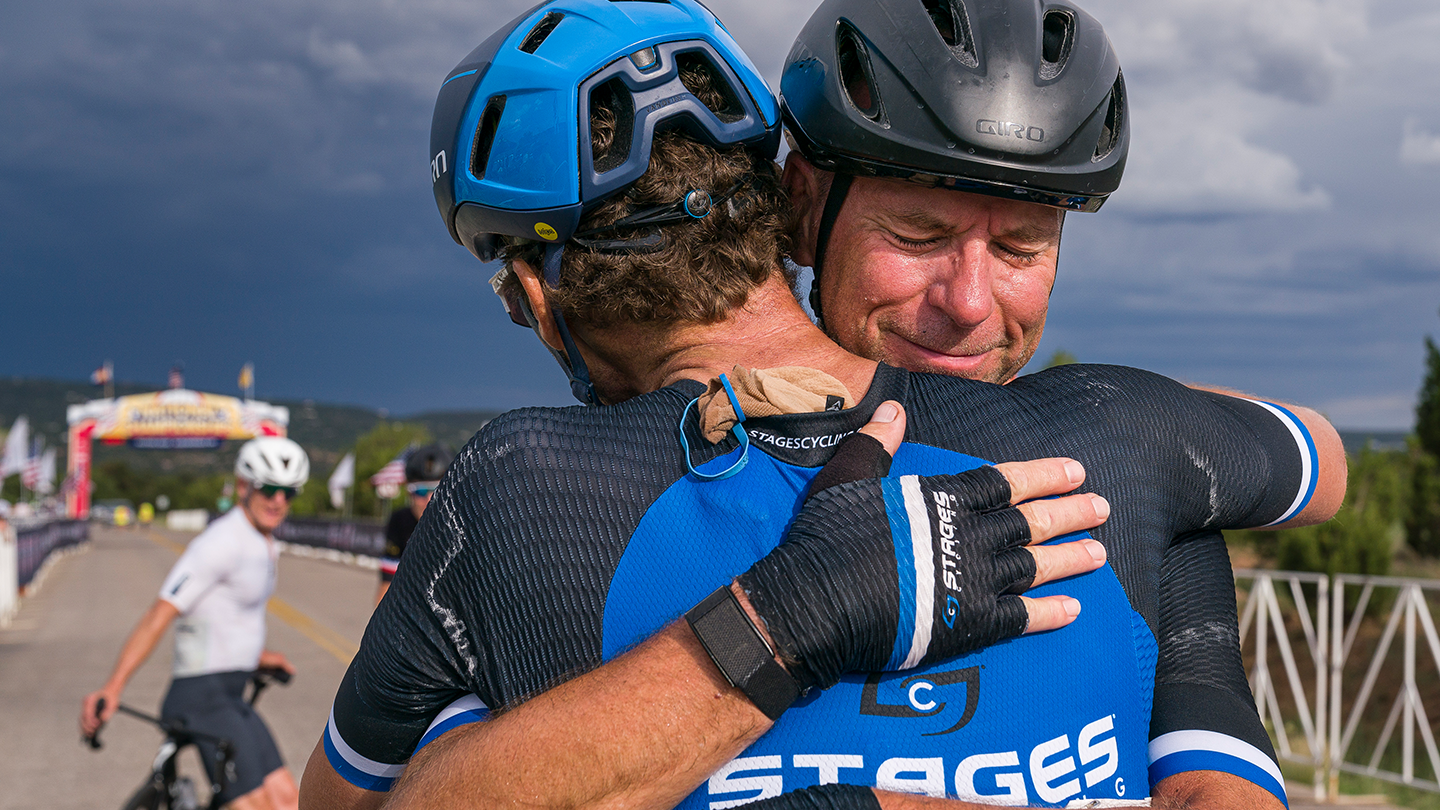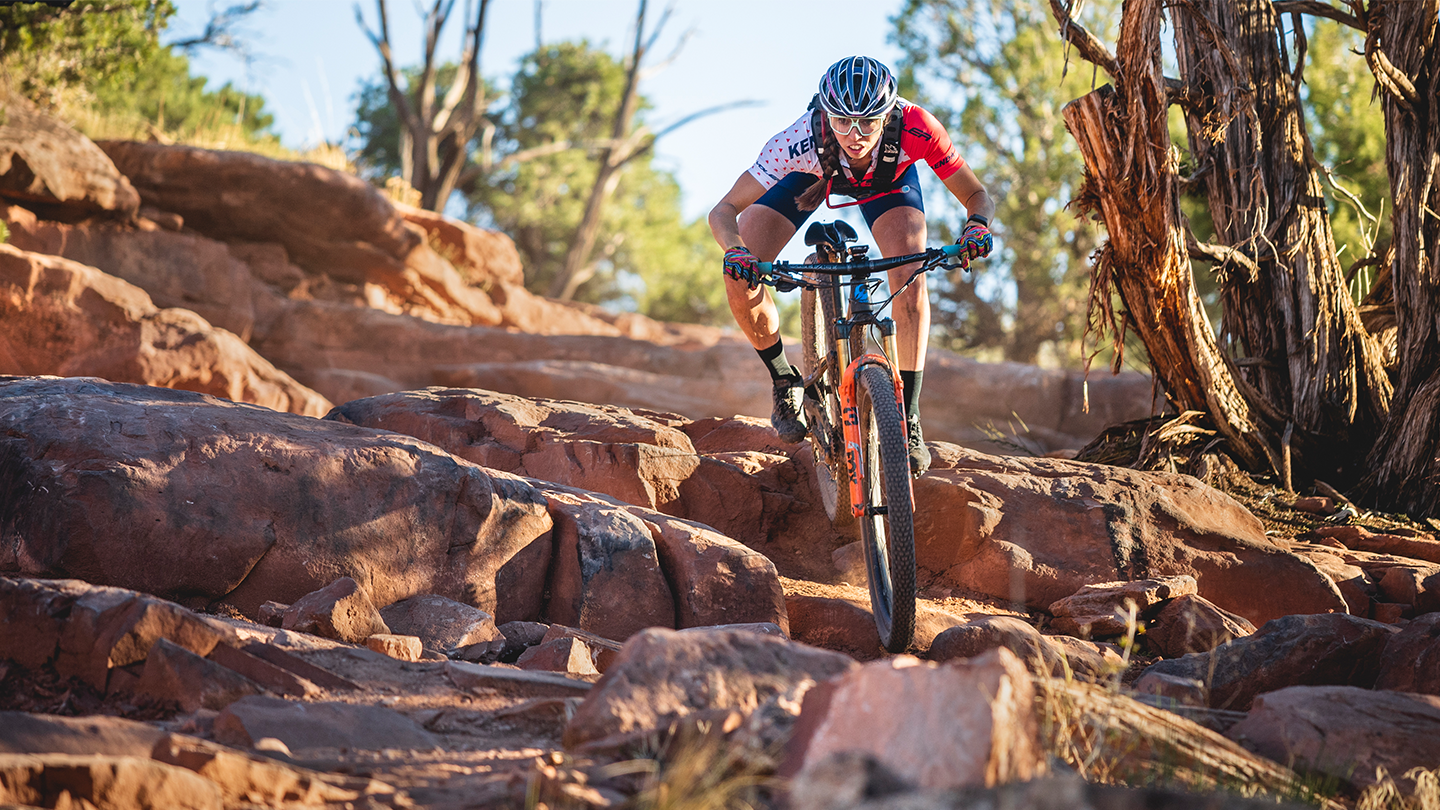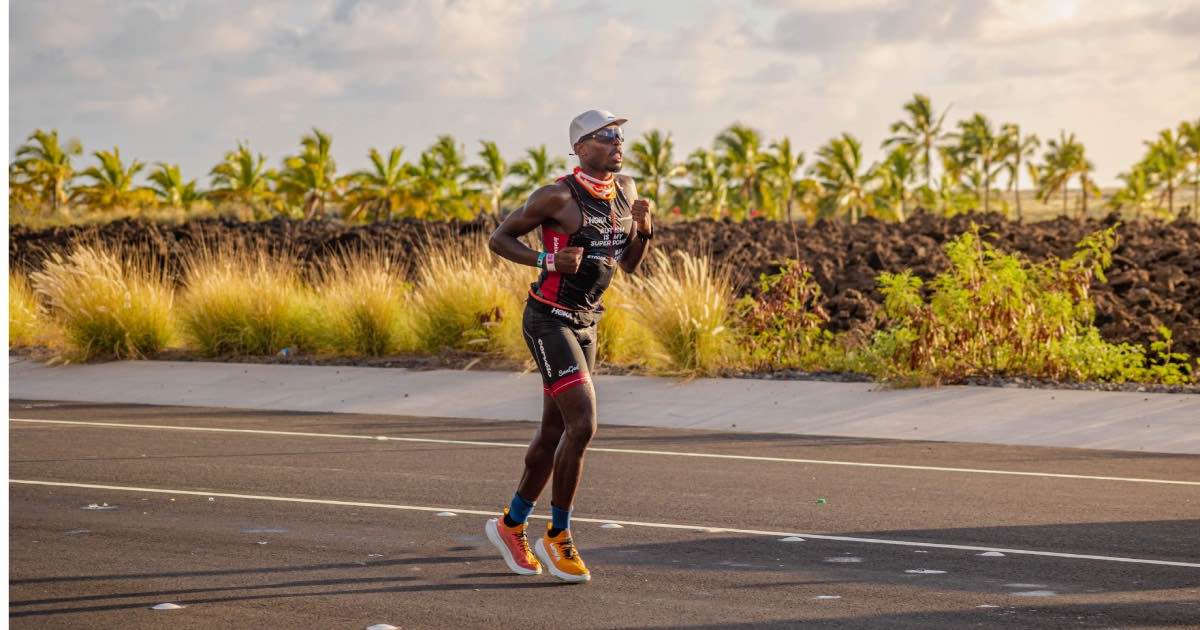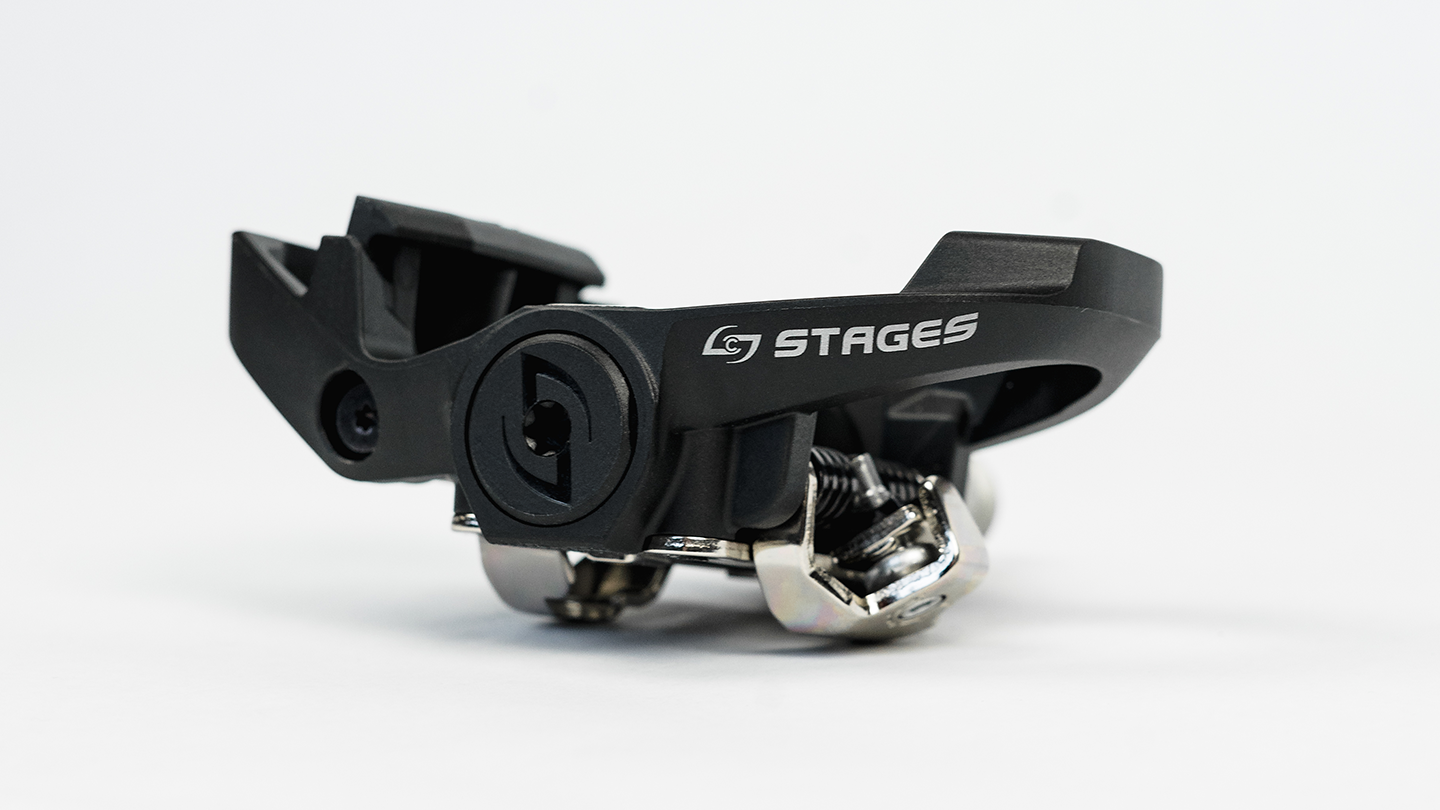Road National Championships Race Strategy and Tactics
- By Benjamin Sharp
- Published: Sep 22, 2022
- Last Updated: Oct 7, 2022
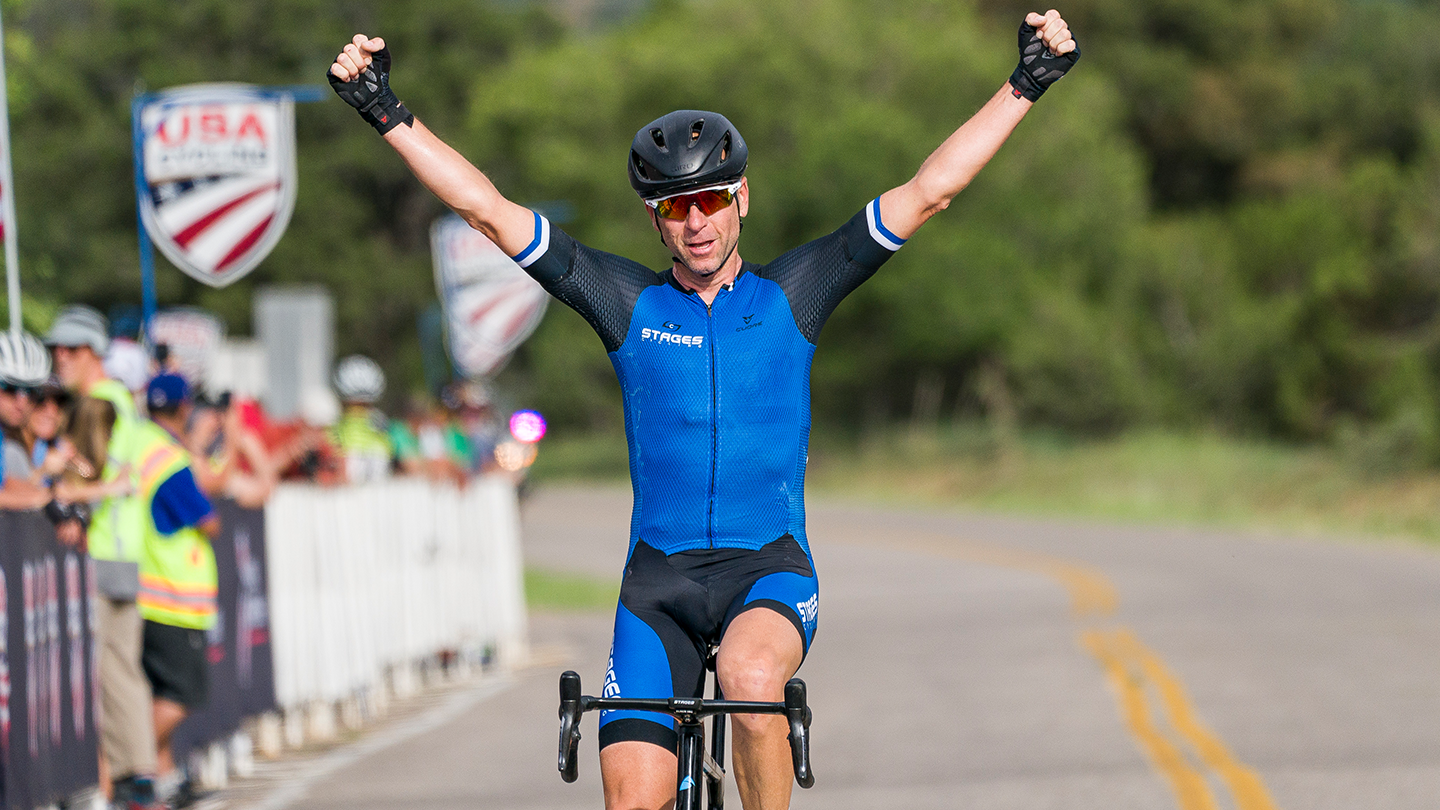
I’m Benjamin Sharp, Cycling Coach and Power Education Specialist at Stages Cycling. Part one of this series, detailing some successes at the 2022 USA Cycling Masters Road National Championships in Albuquerque, NM can be found here.
The time trial lead off the championships on Thursday, August 4. I declined to participate in the time trial as it had been months since I had ridden my time trial bicycle. To go fast in the time trial requires a delicate mix of power, aerodynamic efficiency, and strategy that suits the course. My teammate, coaching client, and Stages VP Pat Warner, exhibited a mastery of those skills to defend his national championship in the 50-54 age group. I think his excellent time trial performance (to be covered in a future blog) was a direct result of all the time he spent preparing for his successful Master’s Hour World Record attempt this past June.
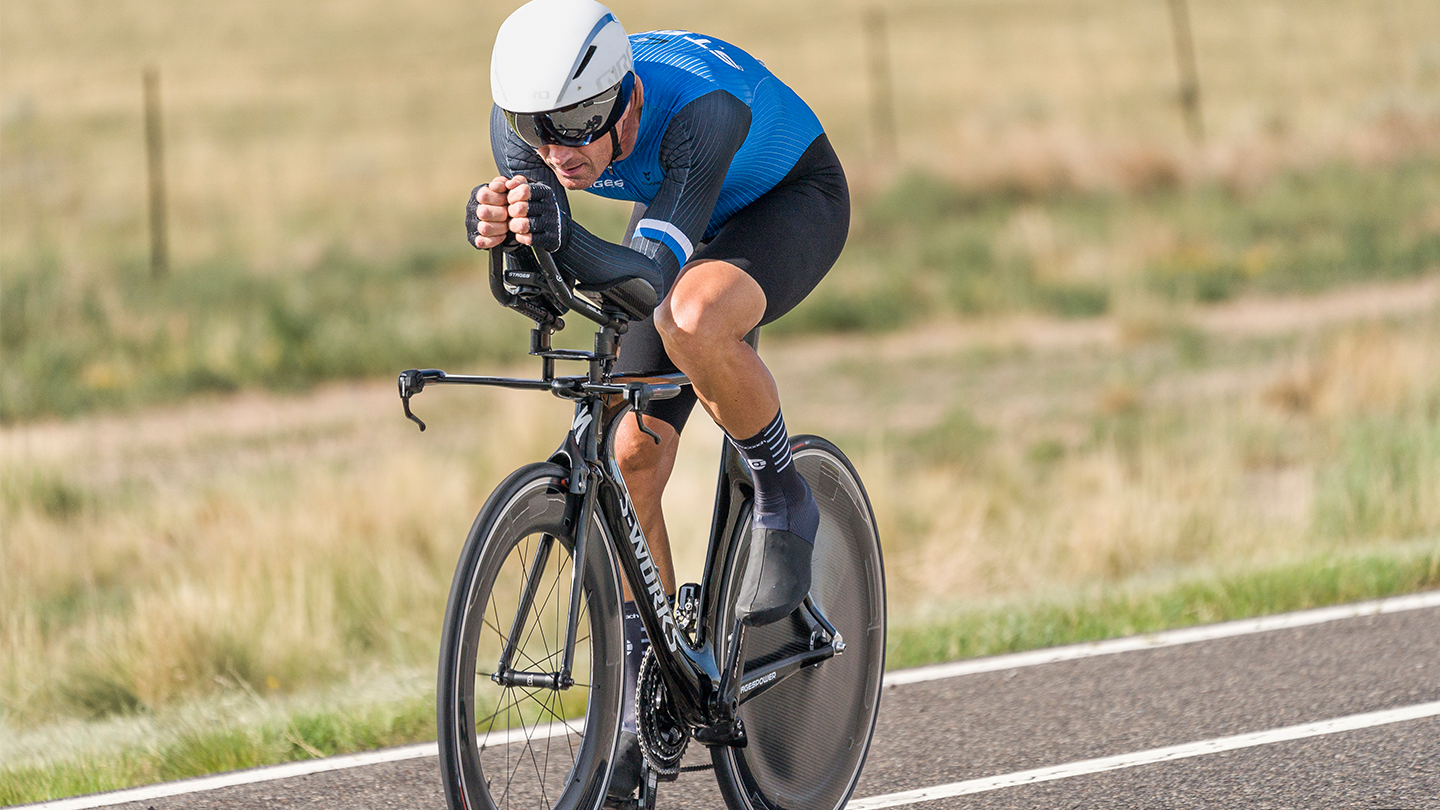

Make a Plan Based on the Course and the Composition of the Field
Celebrations for Pat’s success were short-lived as he and I pinned on a number the next day to compete in the Men’s 50-54 Road Race National Championship. There were about 50 athletes in our race. One team, Peet’s Coffee, was well represented in our race with six riders. The NorCal team is a mainstay of masters national championships and includes several national champions on their roster. The next largest team had far fewer riders, including our Stages Cycling “team of two”. One team having so many more riders than the rest of the field, and the quality of those riders assured that they would have a big impact on how the race would be ridden.
I don’t get nervous before races anymore. I might get excited but it’s very rare to be nervous. I was thankful to stage near a friend on the start line as we could shoot the breeze a bit. This allowed me to get my head out of the race for a few minutes before the start. My whole objective for the race was to make it over the top of the first climb close to the group and to get back on as quickly as possible. After that, anything would be possible. Look back at the first installment of this series for a quick rundown of the course profile and characteristics.
Once we got underway, the race started pretty mellow. It seemed like as a field, rather than a flurry of attacks or hard riding up some of the early rollers, we had all unwittingly agreed that Heartbreak Hill would be the first obstacle in the race. But there was also an unstated acknowledgement that the hill was far enough away from the finish that it wouldn’t be the deciding factor in the race, especially on the first lap. This contradicted what I observed in some of the other age group’s road races the day after my race and those fields were super aggressive from the start. They were so aggressive that in both races, by the time the race reached the bottom of the hill, the winning breakaway was already established. Nevertheless, while I struggled on the climb, the race didn’t go crazy up the ascent.
As we crested the hill on the first lap, I was in about 40th place and approximately 45 seconds behind the front riders. I could see Pat close to 20 seconds ahead of me. As I got to the beginning of the descent, I looked around and realized that a friend, Chris DeMarchi, was just a few seconds behind me. Since he was a lot closer to me than I was to the next riders in front of me I made the decision to wait for him. I took the few seconds of respite to eat a bit and take a big drink of fuel before grouping with Chris, picking up a few more riders, and starting the chase back to the front of the race.
The pursuit was frantic at first but once we could see the field lined out wide across the road, we knew we would make it back with no problem. Within five minutes of the top of the hill, we were safely back in the bunch. Only a handful of riders didn’t make it back to the peloton after the first ascent of the day. As I rolled into the back of the bunch with my chasing companions, I could see Pat, near the front, looking back to make sure I made it back on. I gave him a little head nod, and immediately he attacked.
Having won five of the last seven Masters Road National Championship events he has entered, Pat has a big target on his back. His attack attracted a lot of attention and provoked riders to take chase. Soon after his short-lived breakaway was absorbed, a counter attack went clear with two riders including one Peet’s rider. On the road that gently rolled with a tail/crosswind, they worked together to create a gap of 10-15 seconds.
When a team has a numbers advantage in a race like this, the last thing you want to do is let one of them get in the breakaway. With a Peet’s rider in the breakaway, his remaining teammates in the field have no obligation to do any chasing in the bunch and can sit back while the rest of the smaller teams and individual riders try to bring the breakaway back.
In the short term, I didn’t really see this breakaway as threatening since there were only two of them. There was a lot of racing left (about 80km / 50 miles) and they were soon going to be making the turn into the first headwind section.
I kept in mind that the breakaway included a Peet’s rider as the field briefly accelerated in a crosswind section then sat up. From near the back of the bunch, I carried my momentum past the front of the group and got separation from the field. I made my way to try to bridge the distance to the two riders off the front. I approached them with a huge head of steam and was going much faster than they were. I shouted to them to let them know I was getting close (and to start accelerating). They spread to two abreast and basically looked at each other while I freewheeled past them.
Be Adaptable: The Plan May Change
Neither of the two riders seemed interested in continuing the breakaway. This was pretty much a worst-case scenario for me. Suddenly, just a few minutes after chasing back to the field from the top of the climb, I found myself off the front of the peloton. Alone.
“Well.” I thought, “I have an advantage. I might as well extend it as far as I can and take some of the pressure off of Pat to have to do any work and leave it to the Peet’s guys to take up chase”. My thought process was that when I inevitably get caught, hopefully Pat will be that much fresher. Since he won’t have to do any of the pace making during the chase, and will have good legs to finish well.
The problem with this plan is that I was absolutely floundering off the front. My heart rate was pinned from the bridging effort, the road surface was incredibly heavy and slow, I was battling a little bit of a cross/headwind and I just didn’t feel strong. Trying to put those thoughts out of my head, I put my head down, tucked in to get as low as possible to cheat the wind, and just got on with the task of gaining ground on the field.
After a few minutes of hard pedaling, a quick look under my arm revealed that a group of riders were catching me from behind. After another, longer look, I realized that three riders were bridging to me and the bunch was not taking chase.
Know Your Strengths and your Weaknesses
As the three riders approached, I fueled again with some blocks and fluids and backed off the power a bit so they could quickly join me. Of note, to me, was that there were no Peet’s rider in this group. This meant that the entire Peet’s team was intact in the peloton and therefore could possibly work together to bring back this breakaway. As soon as the threesome caught me, we immediately started sharing the workload.
As a rule, we took pretty even turns in the breakaway. For the most part, I tried to pull on the flats and downhills. If I was struggling with the pace, I would try to pull on some of the many, many uphills, to protect myself and be more in control of the pace, rather than trying to match someone else’s output. Throughout the early part of our breakaway, the moto officials reported a time gap of about a minute. I knew that wouldn’t quite be enough to stay away on the climb on the second lap.
I tried to keep the group motivated by taking longer pulls. I was fairly comfortable with the situation as I even employed the team pursuit or team time trial tactic of focusing most on the speed at which I pulled off of the front. Meaning I tried to steadily and smoothly accelerate throughout my pull so that the next rider in the line would benefit from a slightly higher speed than the speed I had “been given” from the rider in front of me.
It’s much easier to maintain pace than it is to increase pace. I also strategically tried to place myself behind the next tallest rider in our foursome to get the maximum amount of benefit from drafting and recovery between pulls. I dodged a bullet as about 15 minutes into our foray off the front, I heard the unmistakable hiss of a tire puncture and the subsequent woosh, woosh, woosh, as the hole, leaking sealant, struck the pavement with every rotation. Within five or six wheel revolutions, the puncture sealed and I was able to continue on, albeit with slightly less pressure than I had pumped my tires to earlier in the day.
The small hills as we passed through the start/finish area at the end of our first lap were relentless. Unfazed, we carried on, all of us working together to maximize our gap to the peloton. Just before we made the right turn to hit the lower slopes of the steep climb, one of the riders suggested that we try to stay together and ride the climb at a moderate tempo. Before he could get the words out, I enthusiastically agreed.
I was glad that my legs had started to come around and that I was contributing well to the pace. I was trying to demonstrate to the other guys that I was going to be an asset to them after we got over the hill. In other words, “Please don’t drop me on the climb! I will be able to help you later!”. There was still about an hour of faster and flatter terrain where I could help us stay away from the bunch.
Our last time check before the climb indicated that we were nearly two minutes ahead of the peloton. I guessed that we would lose about 45 seconds to the field on the climb. My best estimate at this point was that a small group would go clear of the peloton on the climb and they would eventually join us up the road. I anticipated that that group would contain a couple Peet’s guys and hopefully, fingers-crossed, Pat.
The second time up Heartbreak Hill felt pretty controlled for me. Gaining elevation is never very easy for me but I didn’t go into the red to stay with my friends for the day. I was the slowest up the climb, but only by a few seconds. As we came off the short descent, the motorcycle official informed us we now had a lead of 45 seconds. We were not looking good to stay away. I was discouraged, but I did my best to try to get us back up to speed, rhythmically taking turns and sharing the workload.
As they pulled through for shorter durations and slower speeds, I did feel that some of the impetus had left my companions. Knowing that we were a few miles away from what would be the most challenging part of the course, the long headwind section, I planted myself on the front for a long pull. I wanted to shield my companions from the wind as long as possible so they could rest effectively. My intention was a bit self-serving as I wanted to hit the headwind with as much help as possible to share the pace as the winds tried to slow our progress. After a couple minutes of pulling, I moved over to the side to let the next rider through. To my surprise, there was only one rider on my wheel. We had dropped two of our friends.
Hill Climb Recap
Heartbreak Hill:
- Distance 1.33km (.82 miles)
- Elevation gain: 106m (347 feet)
- Average gradient: 8%
- Peak gradient: 14.2%
- Average elevation: 2140m (7121 feet)
- Peak elevation: 2195m (7201 feet)
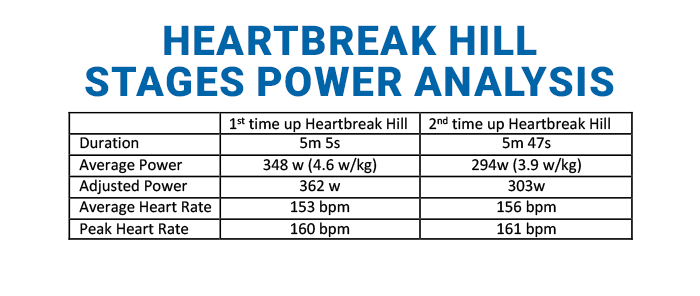

As expected, the increased climbing time between the two ascents of Heartbreak Hill are commensurate with the reduced power. The first time up the hill, while not extraordinarily hard by bike racing standards, was significantly more difficult than the second time. This lower power demand can be attributed to the “agreement” my breakaway companions and I made to roll at a light tempo up the hill the second time. Of note is the increased heart rate on the second time up the hill. This can be explained by the cumulative fatigue of riding in the breakaway for more than an hour before the second ascent, as well as probable increased core body temperature thanks to the warm conditions.
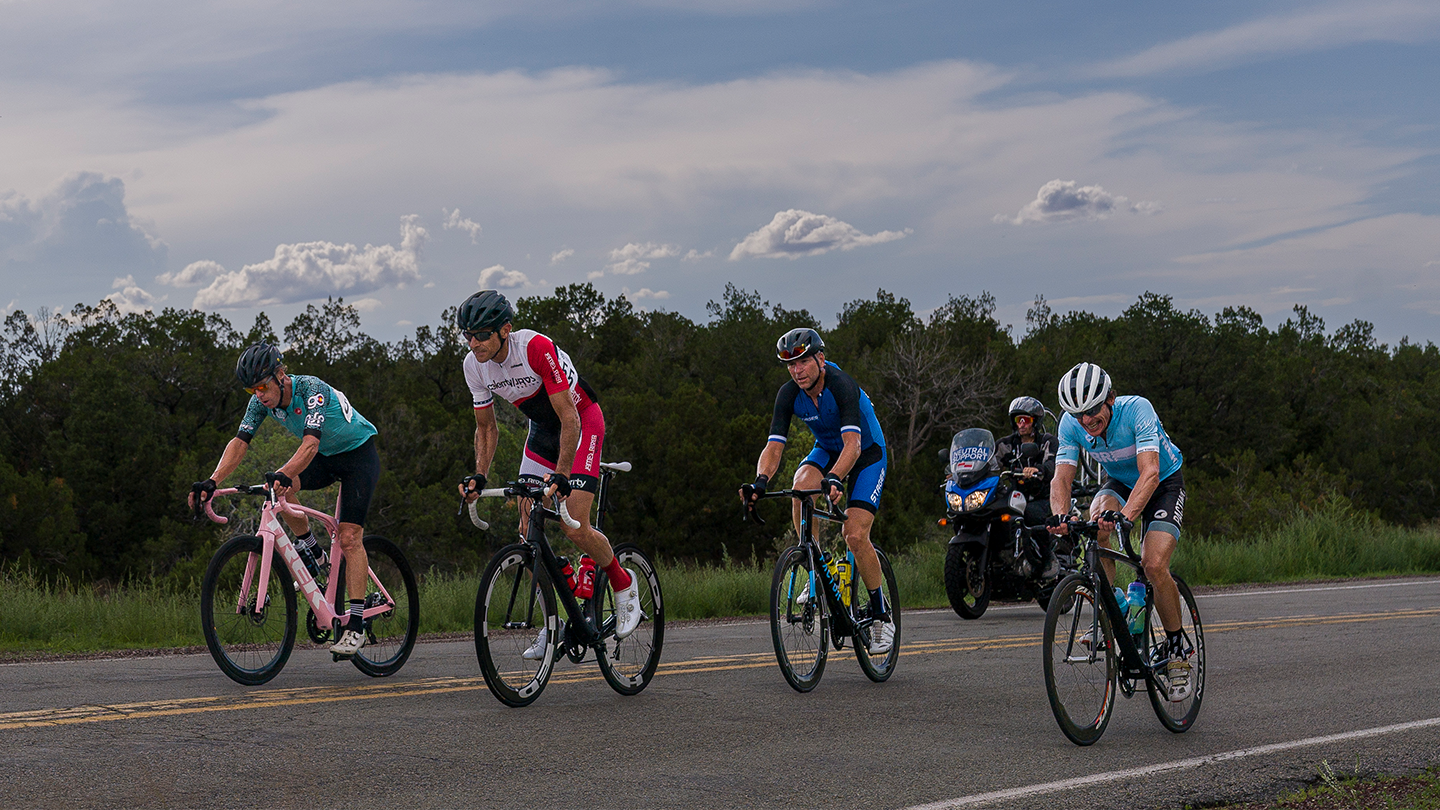

Check in next time for the final installment of this series.
Photo credits: Craig Huffman











